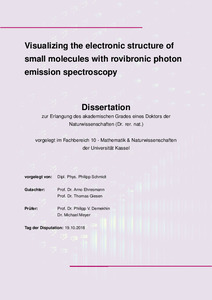| dc.date.accessioned | 2019-02-07T09:20:54Z | |
| dc.date.available | 2019-02-07T09:20:54Z | |
| dc.date.issued | 2018 | |
| dc.identifier | doi:10.17170/kobra-20190206178 | |
| dc.identifier.uri | http://hdl.handle.net/123456789/11074 | |
| dc.language.iso | eng | |
| dc.rights | Namensnennung - Nicht-kommerziell - Weitergabe unter gleichen Bedingungen 3.0 Deutschland | * |
| dc.rights.uri | http://creativecommons.org/licenses/by-nc-sa/3.0/de/ | * |
| dc.subject | Atomic physics | eng |
| dc.subject | Molecular physics | eng |
| dc.subject | Molecular hydrogen | eng |
| dc.subject | Synchrotron radiation | eng |
| dc.subject | Luminescence spectroscopy | eng |
| dc.subject | Electronic structure | eng |
| dc.subject | Molecular deuterium | eng |
| dc.subject.ddc | 530 | |
| dc.title | Visualizing the electronic structure of small molecules with rovibronic photon emission spectroscopy | eng |
| dc.type | Dissertation | |
| dcterms.abstract | A key in understanding the fundamental structure of atoms and molecules has been their absorption and emission of electromagnetic radiation across all spectral ranges. The observation of discrete line spectra contributed to the development of core concepts in quantum mechanics and thus the modern picture of physical processes occurring at small scales. The ongoing refinement of both experimental and theoretical methods in spectroscopy allows to deal with succeedingly more complex systems in different interactions to an ever increasing degree of precision. Still, as this frontier is moved further and further, even the simplest molecules continue to capture the attention of researchers to understand new details of their extraordinary rich spectra.
This work aims to revisit some of the most basic molecular systems and apply the improved capabilities of modern experimental methods to visualize their electronic structure in a particular holistic approach. For this purpose, the spectrally dispersed recording of spontaneous photon emissions is coupled with the high tunability and small bandwidth of synchrotron radiation. The selection of specific upper states with a well defined exciting photon energy allows to record the subsequent photon emissions discriminated by this upper state. If this is performed over the entire range of accessible transitions and sufficient resolution to separate its features in excitation and emission, the underlying electronic structure of the target is mapped in detail. For the regime of singly excited electronic states, these transitions occur primarily in the near to vacuum ultraviolet spectral region with photon energies in the range of several electronvolts.
The first among the investigated species is molecular hydrogen, the smallest neutral molecule and fundamental prototype system in molecular physics. Here, theoretical models are benchmarked with experimental data first and their relevance can go far beyond the field of molecular physics. Its nature as the most abundant molecule in the universe forms the very basis of countless astrophysical processes. The influence of nuclear mass on the electronic structure is then explored by the comparison with its heavier isotopologue, deuterium. An extension to heteronuclear diatomic molecules is finally performed with carbon monoxide, the second most abundant neutral molecule in the universe. Naturally, these three species alongside other diatomic and triatomic molecules serve as the basic models in elementary lectures and textbooks to introduce the concepts of molecular physics. All experimental results are furthermore accompanied by simulations based on numerical solutions of the stationary Schrödinger equation in the Born-Oppenheimer approximation.
The holistic approach of these rovibronic emission maps enables a visualization of the electronic structure of a small molecule, as the individual path it takes in each transition can be traced. This includes many widely known processes as well as the still not fully explored interactions of superexcited states beyond the Born-Oppenheimer approximation and dissociative continuum transitions. On one hand, it may therefore be used as an instrument for teaching fundamental concepts of molecular physics. On the other hand, its separation of individual excitations can reveal details that remain hidden otherwise. | eng |
| dcterms.accessRights | open access | |
| dcterms.creator | Schmidt, Philipp | |
| dcterms.dateAccepted | 2018-10-19 | |
| dcterms.extent | iv, 183 Seiten | |
| dc.contributor.corporatename | Kassel, Universität Kassel, Fachbereich Mathematik und Naturwissenschaften, Institut für Physik | |
| dc.contributor.referee | Ehresmann, Arno (Prof. Dr.) | |
| dc.contributor.referee | Giesen, Thomas (Prof. Dr.) | |
| dc.contributor.referee | Demekhin, Philipp V. (Prof. Dr.) | |
| dc.contributor.referee | Meyer, Michael (Dr.) | |
| dc.subject.swd | Atomphysik | ger |
| dc.subject.swd | Molekülphysik | ger |
| dc.subject.swd | Wasserstoffmolekül | ger |
| dc.subject.swd | Synchrotronstrahlung | ger |
| dc.subject.swd | Lumineszenzspektroskopie | ger |
| dc.subject.swd | Elektronenstruktur | ger |
| dc.subject.swd | Deuterium | ger |
| dc.type.version | publishedVersion | |


